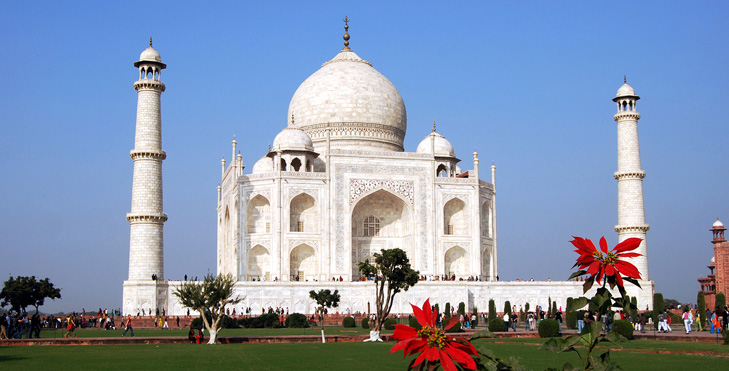Taj Mahal Travel Information
Taj Mahal Description:
The Taj Mahal undoubtedly is the most popular tourist attraction amongst India’s long and impressive list of monuments. The Taj Mahal, popularized over the centuries as a symbol of undying love and eternal devotion, gets over three million visitors every year.
The Taj Mahal is located in the north western city of Agra and was built by the fifth great Mughal Emperor Shah Jahan who was inconsolable over the death of his beloved wife Mumtaz Mahal.
Long considered the most beautiful building in the world and the inspiration of great works in poetry, prose and art, the Taj Mahal has fascinated visitors from around the world for centuries. The Taj Mahal has been on the UNESCO List of World Heritage Sites since 1983 and is counted amongst one of the wonders of the world.
Considered the pinnacle of Mughal architecture in India, the Taj Mahal complex took over twenty two years to build. Construction of the complex commenced in 1631 and ended in 1653. The main mausoleum alone was built in a period of eight years. A workforce of over 20,000 laborers augmented by a variety of beasts of burden and elephants along with an army of artisans from as far afield as Central Asia, Persia and Arabia was committed to the project.
What emerged from this architectural magnum opus is a monument that is peerless in its purity and magnificence. The Taj Mahal while drawing its inspiration from other Mughal garden tombs such as the Itimad-ud-Daulah Tomb and Humayun’s Tomb outdid all of these previous monuments phenomenally. For the first time white marble was used on such a scale as a principal building material as opposed to red sandstone which was the mainstay of such large projects built earlier.
The design, symmetry and minimalism of the Taj Mahal add great detailing and beauty to the mausoleum. Also for the first time the Pietra Dura art form which uses marble fixtures with precious and semi-precious stone inlays to create mosaics and design motifs were applied so prolifically in a tomb. Also used with gusto were various forms of Islamic calligraphy to fill the tomb with verses of the Quran, the Muslim Holy scripture, the 99 names of God as well as classic Persian poetic verse.

The central mausoleum building of the Taj Mahal rests on a large marble base and is a multi-chambered cube with chamfered corners and is 55 meters wide at each side. This is topped by a massive onion dome which is 35 meters in height and is topped with a large brass finial with an Islamic crescent ascendant towards the heavens. Inside the main burial chamber of the Taj Mahal there has been extensive use of the Pietra Dura art form (which is known locally in India as Parchin Kari) along with calligraphy to create a rich Islamic and Arabesque patterned mosaic.
In the center of the main burial chamber are the Cenotaphs of the Empress Mumtaz Mahal as well as Shah Jahan who was buried here in 1666 despite persistent rumors that he intended to make a matching mausoleum of black marble right across the Jamuna River in a symmetrical pattern to the Taj Mahal of his empress.
Around the main mausoleum building of the Taj Mahal are four huge white marble minarets that reach over 40 meters into the sky. While many have conjectured that the minarets have tilted outwardly from the Taj Mahal because of age, this slight tilt was an intentional design element to prevent damage to the tomb in the event of a collapse due to any seismic activity such as an earthquake.
The Taj Mahal has been built to pristine symmetry and is identical on all four sides of the building’s fascia. This obsession with symmetry, attributed to Emperor Shah Jahan, transcends the main mausoleum building of the Taj Mahal Complex into other structures as well. Around the Taj Mahal is the Char Bagh Garden. This is a huge Mughal themed garden which is quartered into four symmetrical blocks partitioned by waterways that have been designed to provide perfect reflections of the Taj Mahal.
On the west side of the Taj Mahal is the main congregational mosque in the complex which is built out of red sandstone. In an effort to maintain the perfection of the symmetry of the complex, a mirror image of the mosque was built at the east side of the Mausoleum which was titled “Jawab” which means “the answer” and serves no functionality other than to preserve the design balance of the Taj Mahal complex.
Around the Taj Mahal there are three main entrances which again are identical 30 meter tall arches that can be used to enter the complex. Another point of interest within the Taj Mahal complex is the Taj Museum which has an interesting collection of Mughal miniature paintings, gold and silver coins of the period as well as a collection of Caledon plates and other royal artifacts.
Best Time to Visit Taj Mahal:
As with the rest of India, any tour to Agra to see the Taj Mahal needs to be planned around two major weather phenomena, namely the searing summers and the extremely wet monsoon rains. This makes the period between October and April the best time to come and tour the Taj Mahal in Agra without being inundated by either.
It is also very important that visitors plan the timing of their tour of the Taj Mahal right to get maximum benefit out of the trip. For enthusiasts of photography, going to the Taj Mahal early in the morning or late at sunset gives you the best photography opportunities.
Furthermore, the Taj Mahal is closed on Friday to all visitors except Muslims coming to pray at its congregational mosque. Similarly the famous moonlight tour of the Taj Mahal is offered only on select nights every month (the night of the full-moon and two nights preceding and following the full moon) to a limited number of visitors and must be booked in advance to ensure availability.
How to get to Taj Mahal:
The Taj Mahal is located in the city of Agra in the western part of the north Indian state of Uttar Pradesh (UP). The city is around 200 kilometers away from the Federal Capital of New Delhi. Agra along with Delhi and Jaipur forms part of India’s Golden Triangle which is the most frequently visited tourism circuit in the country.
While Agra has a domestic airport and a new green-field international airport is being planned, there are at present no regularly scheduled commercial flights to the city. For the international tourist traveling to see the Taj Mahal, the most convenient international gateway is Delhi’s Indira Gandhi International Airport. The airport offers convenient connections and a plethora of airline carrier options.
From Delhi, the most convenient way to commence a tour of the Taj Mahal is by a modern, access controlled, six-lane highway called the Yamuna Expressway. The drive time between Delhi and Agra on the highway is around two hours and can be traversed comfortably in a luxury vehicle.
Taj Mahal Highlights:
It is considered gospel truth in global tourism circles that no tour to India is ever complete without a visit to Agra and the fabulous Taj Mahal.
The Taj Mahal with its matchless magnificence would be of great interest to fans of history, culture, architecture as well as for enthusiasts of romance, poetry and folklore. The Taj Mahal because of its architectural beauty has been of particular interest to fans of photography, videography as well as art lovers from around the world.
Appropriate Attire:
As any tour of the Taj Mahal requires considerable amount of walking around the complex, guests should opt for slip-on shoes and socks for maximum convenience. Also since part of the Taj Mahal complex is a functioning mosque with regular prayer services visitors are required to wear respectable and modest clothing.
Considering the tropical weather of north India, it is therefore advisable that visitors wear loose breathable cotton clothing that covers arms, legs and shoulders. While visiting the mosque in the Taj Mahal complex women visitors are required to cover their heads so keeping a scarf or a head covering is advisable.

